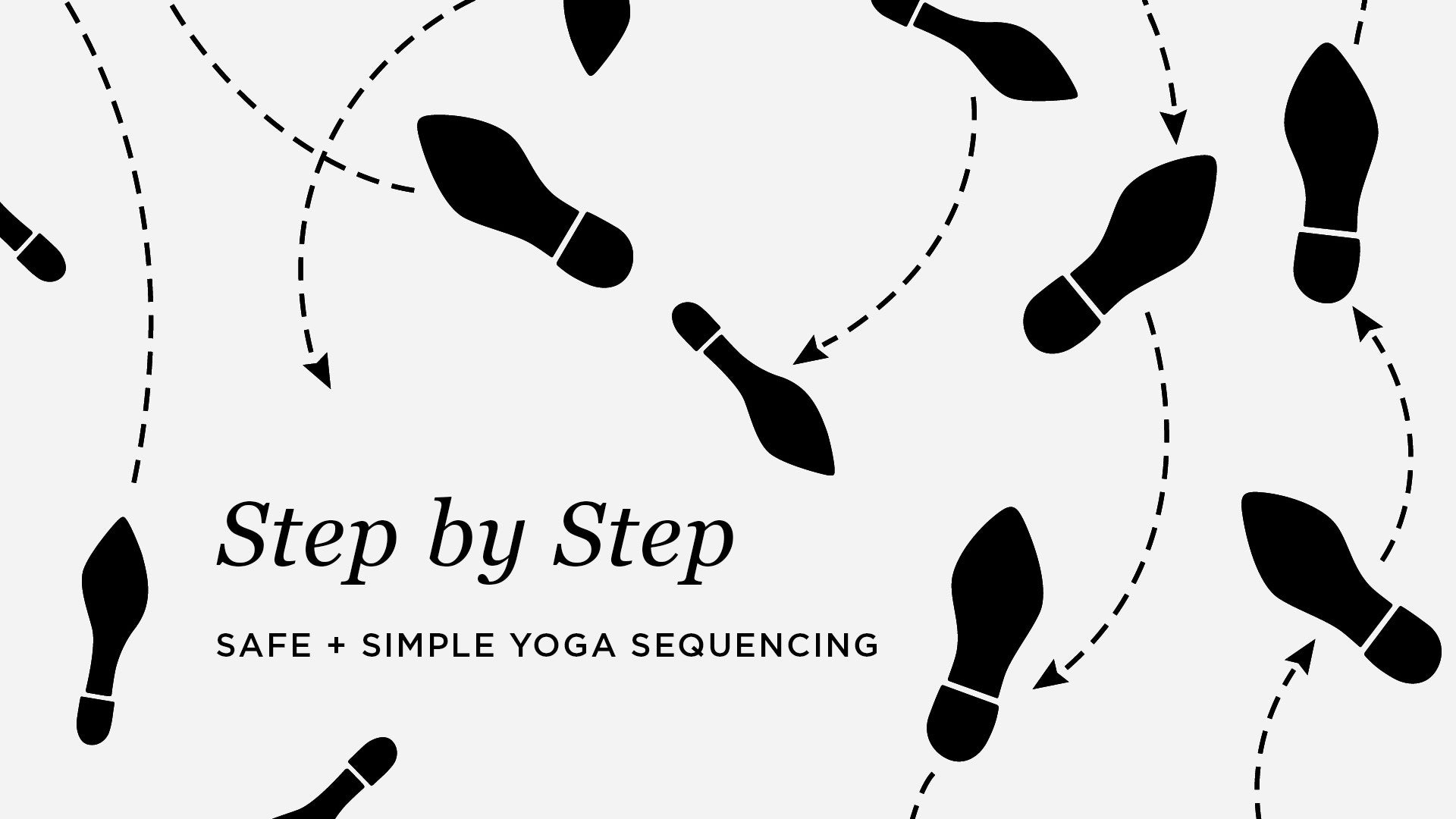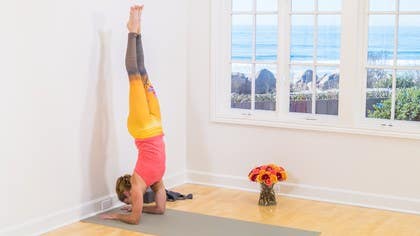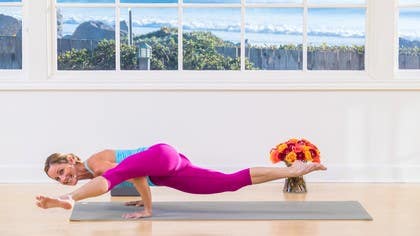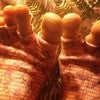Description
About This Video
Transcript
Read Full Transcript
Welcome back. This session we're going to dive into Urdhva Dhanurasana. Urdhva, upward, Dhanur, bow. So upward, bow, pose. For this you're going to need two blocks and a strap. So Urdhva Dhanurasana has many benefits. One, invigorating, uplifting. Two, it can be detoxifying. It can be strengthening through the upper body, through the shoulders, through the chest, through the upper back. It can be lengthening and provide a beautiful stretch through our entire front body, through the abdominals, all the way through our hip flexors. Some contraindications, reasons why this pose might not be for you today is if you have any wrist pain, elbow, shoulder, anything that causes you discomfort that you can't sustain the pose. So in terms of energetics, this pose is working a little bit more of the Vayana Vayu. So we're working out, we're creating space through the center and moving out towards our periphery. We'll also be trying to get longer, so working a bit of a prana energy, the prana Vayu, and then still grounding up on us through the feet and the hands. Great. So to start, we're going to start standing here in Tadasana. So I love Tadasana as this blue blueprint pose, but mostly here we're going to focus on the shoulder girdle. So bring the arms to your sides, flip the palms forward, feel an external rotation, an outward rotation of the upper arms. Let the eyes of your elbows come forward. Good. So just pause here. So the outer shoulders, posterior delts, draw the shoulders back, broaden through the back, and on inhale take the arms up overhead, still with the pinkies and thumbs out. Don't let them turn in and it's going to stay that way from deep in the shoulder joint. So for some you might stay here and say, oh that's okay, that's enough. For some, by the shoulders, by the ears, and back. Good. And pause. So here soften the shoulders down, still find that rotation because this is going to translate right into Urdhva Dhanurasana. If we bend the elbows, flip the palms, and take it back, that's where our arms are going to go. So it starts here. It starts in the shoulder girdle. I'm going to exhale, bring the arms down, and go ahead and come on down to your shins. So go ahead and grab two blocks. Take one to sit on, right, and feel free if you need to sit up a little bit higher, you can grab another block or blanket to sit on. And then bring your other block in front of you, and then take your palms flat against the side. So line up the bottom of your palm to the bottom of the block, and the fingertips might curl over a little bit. Keep the thumbs at the side, right, the tendency is to kind of want to wrap it and squeeze onto it. So you can keep it at the side. From down below, press in, activate that same rotation, external rotation. So eyes of the elbows are going to start to draw diagonally up, right. So so often in classes we hear eyes of the elbows face each other. I teach a little differently where I take eyes of the elbows, diagonal in poses like downward-facing dog, and right here, because I want you to accentuate this rotation. So here, and if you can, then you start to bring the forearms back a little bit, and that'll rotate the eyes of the elbows back a bit. Good. Put a little micro bend through the elbows, and on an inhale, come up halfway. Slide the heads of the arm bones back, so feel that retraction drawing together the shoulder blades. And on your next inhale, come up a little further, maybe like three quarters the way, and pause, right. So you might be surprised that this is actually kind of strenuous. Good. Notice as we start to go up, our ribs again want to start to flare out, bring the rib cage back to neutral. And if you can, come up a little higher, right. See where you can go to, still keeping the action of rolling the inner upper arms now behind you, it's that same action. Outer arms come forward. Sit up a little taller, slide the shoulder blades down, got an exhale come a quarter of the way down. Press the block, put a little micro bend the elbows again, if you tend to hyperextend, it's really easy for you to lock them out. Put a little bend, come down another quarter, slide the heads of the arm bones back, and then come down another quarter, we're gonna go up again.
Inhale, press, draw the shoulders back, come on up a little more, pause, come on up and hold, right. So go to the farthest part that you can go, wrap, scooping out the armpits, broadening through the back, come on down a quarter, feel the heat building, come down another quarter, and then come down another quarter, and slowly bring it all the way down. Take your block to one block to the side, and still stay seated. So as we move into Urdhva Dhanurasana, this upward bow pose, it can be pretty strenuous on the wrist, so just take a moment to stretch out the wrist, flex your hand, draw the fingertips back, right. So if this causes any pain, this is probably not the pose for you today. Right, switch sides. One more each side. Last side. Go ahead and just roll out the wrists. Then we're gonna come down onto our bellies, you're gonna take the block between your inner thighs, and because we're gonna be on the belly, you're gonna line up the face of the block flush with the top of the thighs. So there'll be a bigger end sticking out. Keep a little space between your groin and the block, and then come onto your belly. Good, let the tops of the feet touch the floor. Slide the hands back by your mid ribs, and then let your forehead rest down. Immediately start to draw the inner thighs towards each other, right. So the adductor muscles, add AD, the muscles that draw in, that's what start to lengthen out through your legs when we press up into the backbend. So hands to the mid ribs, moving into Bhujangasana, serpent cobra pose. Inhale, peel up, chest, throat, head lightly. So here we don't want to throw the head back, we're keeping either a long back of the neck, or keep the gaze down. Good, draw the outer arms in. See me and touch the pinky toe onto the earth. Good, exhale, release. A couple more, just warming up the back. Check in here, this is the space our lumbar spine is where we tend to do most of our bending into, because that's where our natural curve is. See if you can get in a little higher, up towards your shoulder blades, up towards the thoracic spine. All right, draw the outer arms in on an inhale, lift up, cobra pose, maybe coming up a little higher. Squeeze the inner thighs towards each other. Good, exhale, release. Forehead down. Each time relaxing the legs as you come down. Inhale, come on up. Good, feel the wrap of the arms, the lift of the chest. Exhale, release. If you are feeling any congestion in the low back, think about what can you do to lengthen? So it might be backing off, not going up as high to really create space. Good, one more time, low cobra. Inhale, lift up, pubic bones still on the floor. Exhale, release. Good. From here, moving into low cobra, this time with the legs lifting, so it's going to activate the legs even more. Inhale, lift up, low cobra, lift the legs. The block might come up, it might not. Still drawing the arms back. Exhale, release. Good, inhale, come up. Good, exhale, release. So in this, with this lift, inhale, come up. You feel the glutes, the bum start to activate. When we're actually in upward facing or in Urdva Dhanurasana, when we're here, your bum is going to be engaged but not over the top. We're going to be holding stability. Exhale, release. Good. From here, gently press back. You're going to keep your one block at your inner thighs. You're going to take your other block out in front. So from here, you're going to press again, palms in like your karate chopping the sides of the block. Take them out, forehead down. Any shoulder mischief, low back pain. See if you can bring the arms back behind you to stay away from that. Press the palms. If available, inhale, lift both. So here, the back of the neck stays long, the gaze comes down. Slide the shoulder heads back. Shoulder blades draw down the back. And exhale, release. Right, so feel the heat building. Relax completely. Inhale, lift up. Feel the action of the shoulders wrapping. And then the outside, the right side and left side, right under the armpits, come around to broaden the back. Good. Exhale, release. Removing the blocks. Just move them off to the side. You're going to take your right arm out to the side, creating a cactus, and take the elbow slightly above the right shoulder joint. Tent the left fingertips. Bend the left knee. Let your right ear touch the floor and slowly roll onto your right side. So now, we're stretching through the right bicep, through the right pectoralis.
So the left foot might touch the floor, it might not. Finding a place that you can sustain. So as we start to get in towards the joints, being gentle. We're waiting for an invitation to go deeper, not forcing. I sincerely unpack this pose coming onto your belly. Take the left arm out, cactus the arm. Left elbow comes a little bit higher than the left shoulder. Tent the right fingertips. Left ear comes down, and then let the right leg come up behind. Right, so this right foot might touch, might not. And then use your right hand just to press in to the left side. Again, you choose the degree of intensity here. Just soften the eyes. Feeling the stretch through the left arm, through the bicep, through the left chest. And come on to the belly. And then come on up to seated. Come back on either to a block or sitting on your shins. And we're going to go into Gomukhasana arms. And I'm gonna turn so you can see the action of my shoulders from behind. So you need to grab your strap if it's not available. So just have it close by. Good. So to start, take your right arm out to the side. Start thumb up. And as you start to spin pinky up, take the arm to frame the ear. Reach back as if you're trying to scratch an itch in your upper back. And then take the left arm and pause here. Right, so this might be it for some. For others, if you know you have more flexibility in the left shoulder, you can take your left thumb up, flip it down, bend the elbow as if you're trying to get a scratch on your upper back and reach for the hand. Or strap or tell or tie anything that's available. So your right inner upper arm is still spinning back. Just as we were in Urdhva Hastasana with the arms framing the ears. Nice, slowly release. Take the left arm out to the side. Flip the pinky up and then frame the ear with your left bicep. Good. Again, still rolling pinky in, thumb out, rotating, inner upper arm back, outer arm forward. And then bend the elbow. Reach for an itch on your upper back and grab right elbow, drawing down. Still keep a space. Draw the ribcage back to neutral. Option to stay here or take the right hand out. Flip the thumb, bend the elbow, take a reach back. So if this, like myself, is a little bit of a harder side, you can always take a little adjustment and then reach back or use a strap, towel or tie. And so softening through the shoulders, working the rotation of the left arm, inner upper arm back behind you, outer arm forward. And then exhale, release. Shake out, roll out the arms just a little bit. And so in Urdhva Dhanurasana, upward bow pose, we're working strong through the upper body, through the shoulders. And we're also going to be working strong through the thighs, through the hip flexors. So just to warm up a little bit, we're going to come into a low lunge. Using our blocks again, because we're going into a back bend, so I want to keep this whole area, our low back, middle back, upper back open instead of coming forward over the lunge. So just using your blocks, take your right foot forward, knee over ankle, left knee, top of the knee. So you want to make sure you're not on your patella, your kneecap. And for again, this variation we're going to go knee stacked over the ankle. Feel a draw back of your right hip, right, as you start to drag the left shin, left top of the foot forward. So we're creating a scissoring action. Take the fingertips back on the block, so see if you can slide the blocks back and lift up, right. You can bend the elbows. If this just feels like the blocks are too high, you can also take them down to medium level. So then bring your awareness to your left thigh, hmm, back into the iliopsoas, the muscle that connects to the top of our femur, runs through our pelvic bone, up and connects to the spine, right. So it actioned in so many things in walking, in sitting, in driving, in texting, in eating, right. All the things we do over and over. So we tend to be tighter in these areas. So we're just taking another three breaths, continue to lift out of the low back, feeling that energy of broadening so the front body gets wide. See if you can lift the heart up just a little bit more, find that shift of outer shoulders rolling back a bit. Then slowly shift the hips back, bring your right knee down, and then take the left foot out. Stacking left knee over left ankle, top of the right foot down. Left sit bone starts to move towards the left heel. Don't give up drawing back the left hip, right hip forward, and then pause. You can walk the blocks back a bit, start to activate through the upper back, right. So remembering those places that are hard to get at. So sometimes we have to be willing to take two steps back to move an inch forward, right. Then often being willing to try something new. That whole idea, if we do what we always do, we're gonna get what we always get. So lifting up a little bit more of the low back, finding space all the way up behind the heart. Shoulder blades provide a nice little support, pressing the heart forward. Just another two breaths.
Slowly come on back to your knees. We're gonna come on to our backs. You just need one block. So come on to your back. Bend your knees. You're gonna take your feet approximately hip distance apart, a couple inches away from your bum. Take your block back to your inner thighs, a little space between the groin and the block, and then draw in. Again, so when we come into full wheel, what tends to happen is our legs want to spray out, creating a broader foundation, but then it's not aligned with our feet. So we're drawing in. If your hips are wider than mine, which is perfect, you can take the block in its opposite in a little bit wider form. So here, you're rolling in and bring your hands, palms down. So to start, feel the rooting through your feet. And then just as in Tadasana, our blueprint for many of our poses, we're gonna activate drawing the inner ankles up. So that draws the base of the big toe mound down, the inner and outer heel, and starts to lift up through the ankles, through the arches. So root to rise, and inhale, start to lift the pubic bone. Start to roll up. From here, flip the palms up. So notice as soon as you flip the palms up, we get that right articulation of the external rotation. So some can stay right here. For others, you can start to creep the shoulder blades under. So we come up right on the shoulder girdle. So our natural curve in our cervical vertebrae moves forward right behind our neck. So we want to have a space between the floor and our neck. Good. For some, if you want to interlace the hands, you can start working the fists down, coming up on the triceps. I like to keep a little bend in my elbows. Press through the feet, lift through the hips, and keep a space between your chin and the chest. Nice, stay soft. And on the exhale, slowly rolling down, release your arms. Take one vertebrae down at a time. So you notice when you're in that pose, your legs are strong. We're working on expanding the back, but some of your back muscles are active.
Those little muscles in between each vertebrae are holding stability. Our bum is holding mild tension just to keep our hips stable, right? So we don't want to squeeze too much, and we don't want to just let it go. We're holding just a little bit. Good. So you have an option to stay right here, feel like, oh gosh, that was just enough, I'm at my edge. Keep doing bridge pose each time we come up. Okay, so an option, stay right here in bridge pose, or we're going to learn through the setup of how to get into Urdhva Dhanurasana safely. So moving into Urdhva Dhanurasana, and we're going to keep our block here, just to keep our legs active. You're going to take your finger pads by your shoulders, flip the elbows up. So right here, you can already see that this can become intense on the wrists. As you start to lift, we're going to come on to the crown of the head. For this one, we're not going to come all the way up. We're just going to lift, right again, making the back body broad, broadening through the belly, and as you lift, come on to the top of your head. Good. Adjust your hands, so wrist creases are parallel, and then draw the outer arms in, so this should look a lot like Chaturanga arms. So this is our setup, where we're going to move from. Good. On an exhale, tuck the chin, slowly lower all the way down. We'll have the chance to come back to that real soon. So grab two blocks, come to the wall, two blocks at the wall, then you need your strap, and your straps going to be shoulder-distance apart. So this, for many, is pretty intense. If you haven't used a strap in a back bend before, it can feel kind of claustrophobic. So with using the blocks at the wall, putting our hands on the blocks, it allows more space to get in, so it should be a little better than just jumping into it right on the floor. So you're going to slide the tail out of the way. Blocks are against the wall, so they won't slide anywhere. And then come on down. So feet hip-distance apart, that's where we're rooting. Let me tighten this up just a little bit. All right, hands come behind, so instead of finger pads right by the shoulders, they're gonna come on to the blocks. Right, so this can be intense on the wrist. So I start fingertips wrapped around, and as I lift up, my pads and my hands are gonna come down. So on an inhale, lift up through the pubic bone.
So now my chest is lifted, almost like I'm in bridge pose, and then on an inhale, come to the top of the head. So right here, fingertips can be wrapping. I just want to make sure the base of my pointer finger, base of thumb, is on the on the block. And when you're ready, inhale, press all the way up. So again, my feet feel a little claustrophobic. You can work the forehead around, and you can press into the strap. Right, so that pressing and the wrapping is gonna give a space into the chest. Okay, so eventually we're working to lift our hips and lift our chest just as much. So sometimes going against the wall, we can press a little bit more into the chest, just to hyphen and exaggerate that space, and then come back to neutral. So eventually low ribs, hips are gonna be even. Good, and then as you come down, watch the strap, tuck the chin, lower all the way down. We're gonna spin this time, putting feet on the blocks. Right, so we all have our different work. Sometimes it's tightness in the shoulders, sometimes it's tightness in the hips. So when we flip this, putting our feet on the blocks, this gives us more space through the hip flexors. A little bit harder to get up in a little more claustrophobic with the strap on this side. So again, take the tail, get it out of the way. Make sure the blocks are lined up against the wall so they don't slide anywhere. And then scoot on up, come on back, feet to the blocks. Make sure they're about hip distance apart. We often think our hips are bigger than they are. Scoot on up. Hands come back behind fingertips, finger pads by the shoulders. Good, as you root through the feet, you're gonna lift up the same way. We're gonna come down to the crown of our head. Right, adjust. You can squeeze against the strap that's gonna give you some space and then press up. Right, I like to kind of move my head through. So the straps kind of pressing against the forearms. Sorry, strap is pressing against the forehead. Keep lifting. So notice here the knees and outer thighs want to spin out. See if you can spin the inner thighs down just to keep them in line. Gives a little bit of space to the low back but there's still a pressure of the outer thighs pressing down. Nice. On the way out, tuck the chin, watch the strap. Back touches before the head and come on down. Take the strap aside, blocks aside. Moving into the final one, Urdhva Dhanurasana. Without block straps, if you feel like your shoulders are too tight and can't come up, you can come back into that prep pose. So lining up, come on back down. Feet press and then start. Palms up. Right, so that just sets the shoulders. On an inhale, lift up, roll it up, take a pause. Start to slide the shoulder blades under. Option to stay right here. If you like, bend the elbows, bring them back behind and then start to lift on up. Right, either one swoop or you can come back up top of the head and then press. Good. So as you root, find the spin. Scoop out the armpits. Draw the inner thighs down with equal pressure, outer thighs down. Maybe walking the feet in just a little bit. So the question is what to do with the head? Right, so we don't want to crank the head back. We're gonna let it go so arms frame the ears. And then exhale, tuck the chin, come on down. Roll it down. Ah, bring the knees in. Right, so after doing lots of back bends, twists can feel lovely. So just take the arms out to the side. Let the knees drop off to the left. Let the right shoulder drop down. And maybe taking the gaze off to the right. And then slowly just come up to center. Knees drop off to the right, gaze to the left. Bring the knees back to center. Draw them in just a little bit. Ah, panasana can just be light. And either rolling off to the side or just rolling up, coming to seated. Just take a moment to sit. If you feel like you need more grounded time, feel free to lay in shavasana. Feel free to sit here for a bit. But just to recap and moving through urdvandana, pretty strong through the shoulders in flexibility and in strength. So taking the time really to move in. And again, being willing to take a couple steps back to move an inch forward. Working through creating more space through the entire back and making our front body bigger. Right, not just cramming and trying to go deeper, but taking the time to create space in our body, creating volume. And then the legs are strong, stable, and having control of our legs. Because sometimes they just want to go out, do their own thing. So you can just drawing them in. So thank you all for diving into urdvadhanurasana with me. I look forward to joining me on another session. Namaste.
Step By Step
Comments
You need to be a subscriber to post a comment.
Please Log In or Create an Account to start your free trial.










